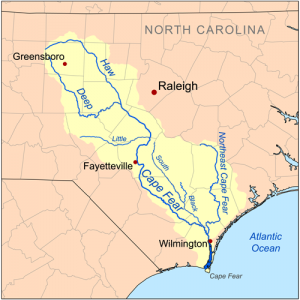History of the Haw River
Almost a million people live in the Haw River watershed. The oldest settlements along the Haw were small Native American villages. The Native Americans who lived along the Haw River were part of the eastern Siouan people. They lived bountifully off the land by hunting, fishing and farming for thousands of years before European settlers arrived. UNC-Chapel Hill has researched archaeological sites along the Haw and some of its tributaries in Alamance County. These sites reveal much about how the Sissipihaw (also called the Saxapahaw) lived. Lacking broad floodplains, the Sissipihaw People lived in small, interconnected villages on ridges overlooking the lower half of the Haw River. They constructed houses and storage huts made of saplings, logs and bark. At least one village site had fenced boundaries. They hunted the abundant wildlife of the watershed, including deer, raccoons, possum, turkey, fish, and shellfish (both mussels and crayfish). They gathered wild plants, nuts and fruits, and cultivated crops such as corn, beans, and sunflowers. It is believed that peaches were introduced to the Americas by the Spanish and gained much popularity with Native Americans, who were growing them throughout the land long before other Europeans settled here. Pottery was not only utilitarian, but also an art form with many styles of decoration. From pottery shard samples collected by archaeologists, we know that one such design was made by rolling corncobs across the surface of the clay to create a geometric design. The skill that went into making arrowheads and other tools is evident in the ones still being uncovered today.

German, Scotch-Irish, and English immigrants came in the late 1700’s building farms and settlements. Grist mills for grinding grains sprung up along the Haw and its creeks where drop-offs made good dams and mill races. Forests were cut down at an amazing speed for lumber and farms. One by one the larger animals declined or disappeared — wolves, bears, beavers, otters, eagles. Although most settlers were yeoman farmers, there were also some large slave-holding farms or plantations.
Due to the large number of Quaker people, especially in Guilford and Alamance Counties, the Underground Railroad had many stations (safe houses) in the Haw watershed. Escaping slaves used the Haw River and its tributaries as landmarks on their way North to freedom and to put off trackers.
In the mid 1800’s, the state of North Carolina promoted the building of hydro-powered textile mills along the rivers of the Piedmont. These mills would create new jobs and money while utilizing the cotton grown in the state. Many factories were built along rivers in the settlements where older gristmills (to grind grain) had been. Rural people from failing farms, women, and children, made up much of the early work force.
As times changed, new mills were developed that did not depend on water power, and were built away from the river. Although some of the first cotton mills were modernized and continued to run for many years, they are now closed down and stand today as quiet reminders of another era.
